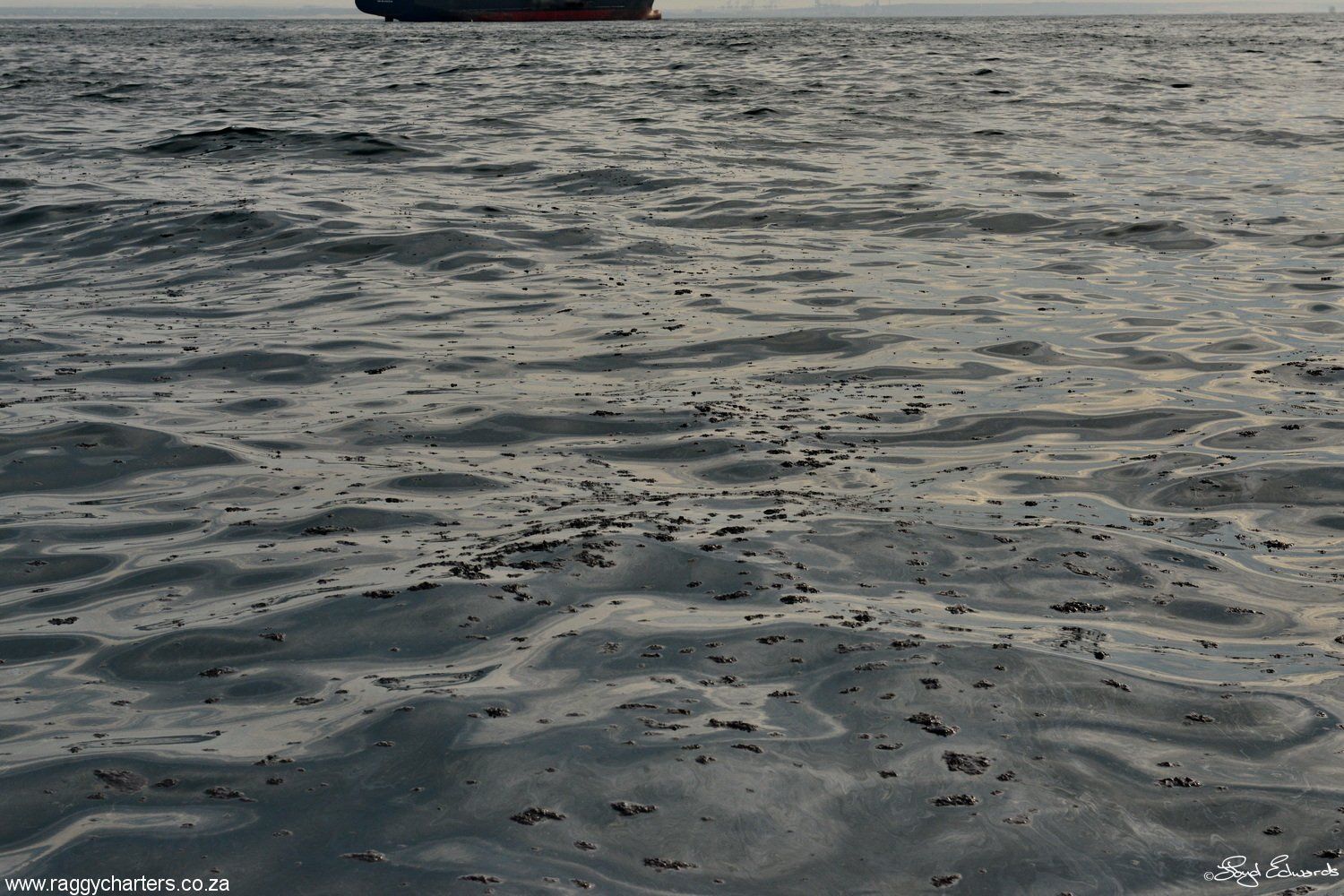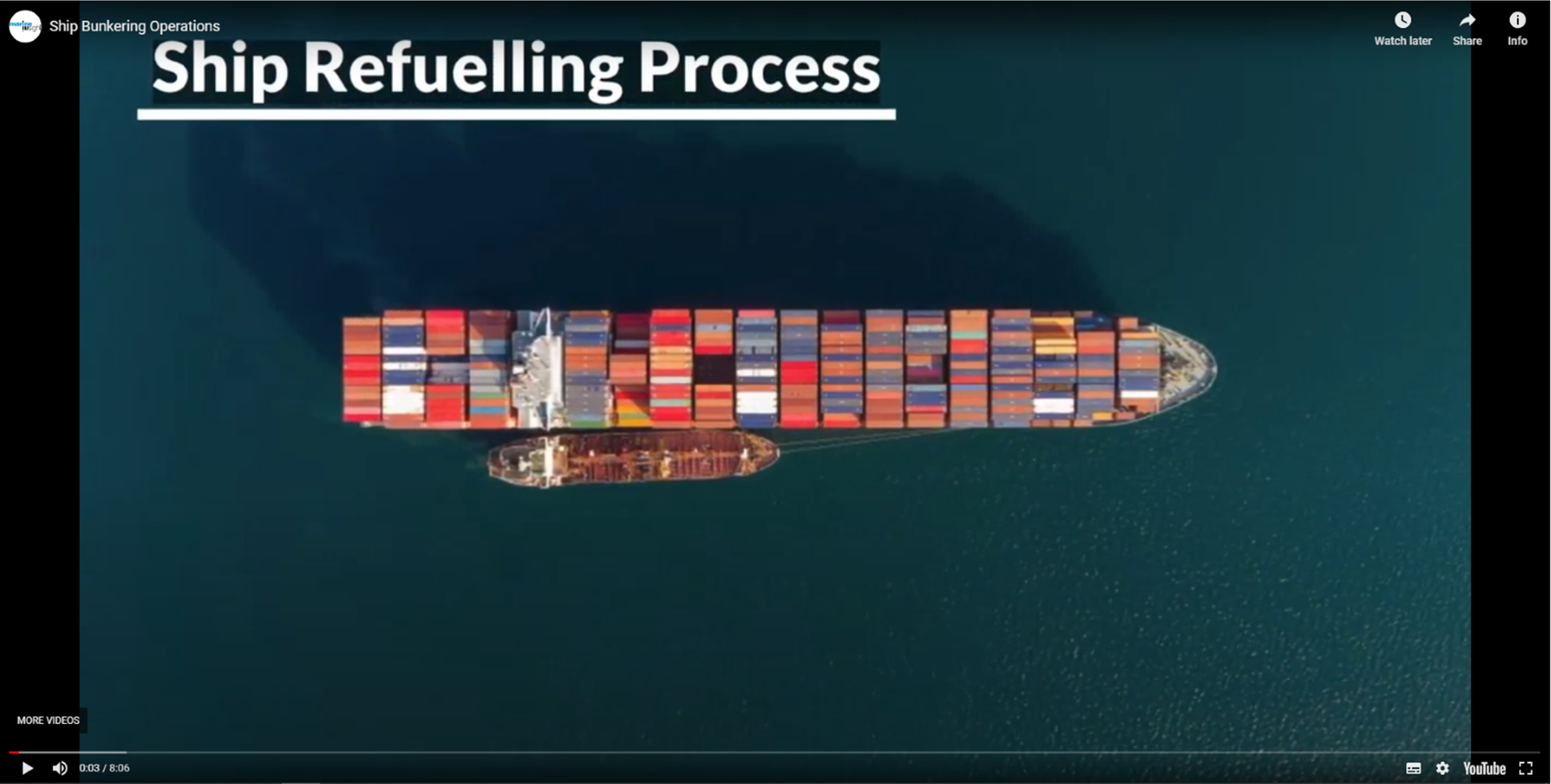STS Bunkering vs Endangered African Penguin
THE STRUGGLE CONTINUES FOR THE AFRICAN PENGUINS IN ALGOA BAY!
ALGOA BAY OIL SPILL HOTLINE
Yes you can help our endangered African Penguin: https://www.sanaturejournalerscommunity.com/post/artivism-for-african-penguins
PLEASE HELP.. SIGN THE PETITION
The headline says it all!!
To read more .. (enter your email address on the link )
IS the below fact or fiction as the proposed regulations are sent out for comment....
A slight relief 12MARCH 2025 ... but bunkering needs to stop!



Read the full statement ![]() https://bit.ly/4bIugsG
https://bit.ly/4bIugsG
https://sanccob.co.za/news/high-court-victory-for-the-critically-endangered-african-penguin/

Ship-to-ship bunkering is again well underway in Algoa Bay! 
https://maritimereview.co.za/Articles/ArtMID/397/ArticleID/584/Tanker-added-to-South-African-registry
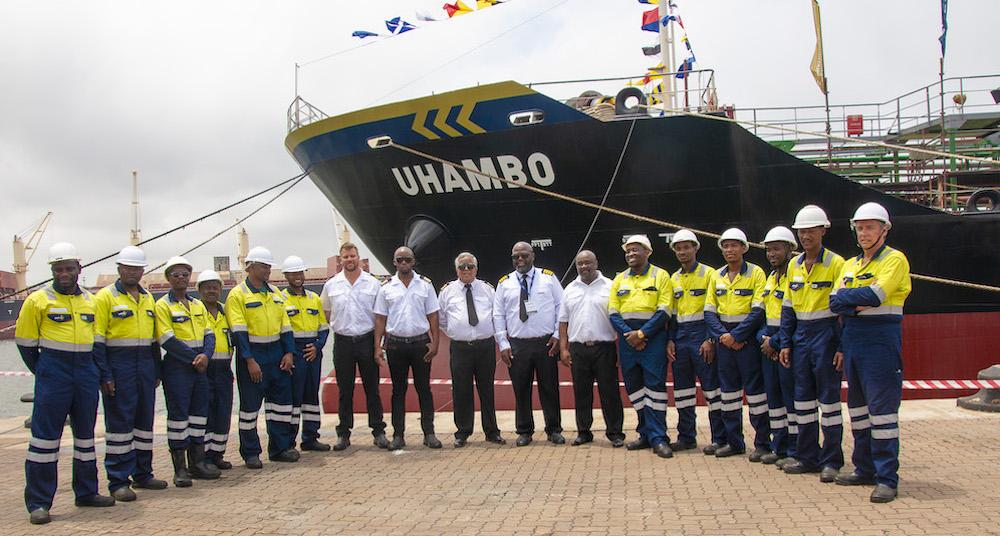



We must not let Bunkering start again....

THE HERALD ARTICLE 19 Dec 2024

FARMER's WEEKLY 6 Dec 2024
ANOTHER OIL SPILL IN ALGOA BAY - 7th September 2024 !!





The research continues - lastest article to read 03 Sept 2024:

World Cetacean Alliance August Newsletter:
Good news published by Business Day 21 August 2024:



It is with much delight that we received news that the African penguin breeding pairs on St Croix Island in Algoa Bay is on the increase. Last year they reached rock-bottom, with only 700 pairs left. This year the colony has grown to 1200 pairs, this is fantastic news!
The main reason for this increase in the penguin colony is that Ship-to-Ship (STS) bunkering has been prohibited since September 2023. This was due to financial issues where the tax man was wanting his fair share of the oil transfers that are taken place in the bay. It seems that an impasse occurred between SARS and the operators, to such an extend that the taxman impounded some of the bunkering vessels, and prohibited any further STS transfers.
We had a long and hard battle for more than 5 years against this extremely hazardous fuel transferring operation occurring, on the open sea, in our bay. In this time we have seen the world’s largest colony of African penguins plummeting, losing 85% of the colony. This was a catastrophic ecological disaster, caused by the selfish and possibly unlawful STS bunkering operations.
Not only has the numerous oil spills influenced the marine environment, it also led to oiled penguins that had to be rescued. Many did not make it. Furthermore, the visiting vessels moved across the foraging area of the penguins, negatively influencing their feeding habits, and causing pollution, emissions, noise and contaminated water discharges.
From the beginning we have voiced our utmost resistance to the bunkering vessels in the bay, transferring oil close to the marine protected area and St Croix Island. We organized public meetings, submitted concern letters and reports to the ministers and operators, obtained legal opinion, used printed, television, radio and social media, all while protesting the inconceivable deed by government to permit this hazardous operation. We did not stop and used every opportunity to address this injustice done to our bay, tenaciously fighting to protect our penguins.
In the end, in 2022, Minister Barbara Creecy (then minister of DEFF) had to agree with us, and ordered a risk assessment to be done. The results of the assessment put specific restriction to the STS bunkering operations. Possibly the restrictions, together with the financial mess that they found themselves in, were too much for the bunkering fraternity. The operators vanished overnight- leaving the bay to recover from the damage caused by them.
And recover it did.. to our delight!
Now, after less than a year, the colony has grown by 70%! This is an indication of just how huge and absolute devastating impact STS bunkering had on the penguin population for so long. As soon as bunkering was gone, the population bounced back and flourished. We are holding our breath, hoping that this trend will continue year-on-year.
We would like to thank each and every one who helped us in various ways on the path to protect our penguins. From being in despair, we are now cautiously optimistic for the future of the penguins in Algoa Bay.
Who knows, maybe one day we will again be able to claim the accolade for the largest colony of African penguins in the world!
I hope that day will come soon
Read the News Article
We are very excited to hear this news - the latest update on the Bunkering in Algoa Bay - click image to read full article.
uPDATES: 13 fEB 2024 mAIL & gUARDIAN and NEWS24 17 Jan 2024
The Mail&Guardian article is a great summary of events in STS bunkering by Kate, an environmental lawyer. Algoa Bay Conservation submitted comments on the risk assessment to the environmental consultant on 31Jan 2024. Our comments were on the significant noise levels that cannot be mitigated.. indicating a high impact on marine life. We also commented on the poor socio-economic study that provided no information on why we should take all the risk and have so to say no financial benefit. We also raised the SARS issue that is currently in place. In addition we highlighted the inability of TNPA to perform their current monitoring in the bay, while the consultants as part of mitigation assigned more monitoring responsibilities to them. What if TNPA does not do it.. there is no consequence.
We are awaiting feedback on the comments submitted. I trust with the increased interest of environmental NGOs and environmental lawyers we will be able to put a stop to STS bunkering in our bay.
Algoa Bay Conservation started small in 2019 in making people aware of this highly unacceptable risky operation in our bay. It took very long, with dire consequences to the penguin community at St Croix, but maybe now we can protect the greater MPA from degradation and conserve our marine life. With STS bunkering its not a matter "if" a next spill will occur.. it is "when" it will occur!
UPDATE in the weekend Post 5 augusts 2023

update in the Herald 5 june 2023

16 Sept 2022: Minister Creecy announces temprorary relief for penguins


Please take a moment to lend the African penguin your voice. This is our opportunity to affect change! Written comments/inputs can be sent to marinespecies@dffe.gov.za by no later than 21 August 2022.
Request the South African government to prioritise the following actions, which we believe will give the African penguin a fighting chance of survival:
- Ensure availability of forage fish for African penguins in key forage areas throughout their annual cycle.
- Minimise and/or mitigate the impact of catastrophic events on African penguins: Oil spills.
https://www.dffe.gov.za/https%3A//www.dffe.gov.za/draftbiodiversitymanagementplan_africanpenguin
20th July 2022 Environmental Scientist Ronelle Friend, Updates on the situation with the African Penguins in Algoa Bay

The current situation (June 2022)
Observations at St Croix island recently have shown very few penguins visible on the lower reaches of the island. This is in extreme contrast with the historical numbers of penguins anticipated to be seen at what was the largest African penguin breeding colony in South Africa.
The Algoa Bay Conservation Group have updated the penguin breeding pair data and their monitoring graphs to depict the current situation.
The attached graph depicts that since 2015 to now, St Croix Island has lost 87% of the African penguin breeding pairs. In real terms it equates to 6 616 pairs, or 13 232 penguins.
The average loss of penguin pairs during the last 5 years, since 2017, is 1000 pairs per year. Thus every year a thousand less pairs of penguins have bred on the island.
The amount of breeding pairs remaining on the island is currently ~ 1200 pairs (Data provided by Professor Lorien Pichegru and DFFE).
If the trend continues there will virtually be no breeding penguins remaining by next year!
Scientific opinion is that breeding African penguin pairs “do not move from a colony, once they have started breeding, but have died.” (Facebook Prof Lorien Pichegru, 11 June 2022)
It must also be stressed, for the benefit of any persons uninformed, that African penguins are indicator species which can be counted when breeding, and the demise of such species is cause for concern for the health of the marine habitat in general, and other marine animals, such as seals, cetaceans, fishes, sharks and other sea birds in particular.
Possible causes of African Penguin Decline St Croix Island.
Minister of Environmental Affairs the Honorable Ms. Barbara Creecy in October 2021 correspondence, following a letter of concern, promised a “comprehensive risk assessment to be conducted and relevant concerns addressed.”
This assessment has been called for since the commencement of ship-to-ship bunkering in 2016, because of the inherent risks to the environment and the siting of the bunkering anchorages close to and having a direct impact on sea bird foraging areas.
An extract from Transnet National Ports Authority (TNPA) 2021 Annual Report explains a possible reason for this failure to respond by the responsible authority:
“Management of sensitive habitats
TNPA’s long term ecological monitoring of the marine environment did not take place in the ports of Cape Town, Mossel Bay, Port Elizabeth, Ngqura, East London and Richards Bay due to expiry of the contract, and the budget being cut.”
The most likely cause of the demise of the African penguins of St Croix island is a decline in historical prey food availability, being sardines and anchovies, within their foraging habitat.
Anthropological intrusions that impact on the penguin foraging habitat have been documented, and include commercial pelagic purse-seine fishing, uncontrolled marine traffic, and ship to ship bunkering and resultant oil spills. The decline in breeding penguin census numbers, as shown on the graph, coincides with the start of STS bunkering in Algoa Bay which suggests that this intrusion is ‘the smoking gun’ in the African penguin demise. Whether it is the number of oil spills, or the substantially increased vessel traffic with attendant noise and vibration pollution, or wastewater and vessel sewerage discharges; only a proper scientific assessment with specialist studies will determine.
We also say that such an assessment should have been performed before a decision was taken to permit STS bunkering in 2016, when licenses were issued to operators and without environmental authorisation.
Environmental legislation is very clear, that if the consequence of any activity is likely to have an adverse impact on the environment, the cautionary principle must be applied to decision making.
The current situation depicts an extreme ecological disaster in progress and demands urgent and radical intervention in an attempt to salvage this breeding colony of African Penguins.
Algoa Bay Conservation Group June 2022.
Carte Blanche 9th June 2022
 Ronelle Friend of Algoa Bay Conservation, Dereck Watts and Liz Fish from Carte Blanche and Lloyd Edwards of Raggy Charters head out on catamaran "My Bru" to inspect Bunkering and what is left of the African Penguins on St Croix Island.
Ronelle Friend of Algoa Bay Conservation, Dereck Watts and Liz Fish from Carte Blanche and Lloyd Edwards of Raggy Charters head out on catamaran "My Bru" to inspect Bunkering and what is left of the African Penguins on St Croix Island. Scientists have pointed out that it may be too simplistic to project a population trajectory like on the graph, so please bear that in mind.
Scientists have pointed out that it may be too simplistic to project a population trajectory like on the graph, so please bear that in mind. St Croix Island in 2002 before overfishing for sardines and anchovies in Algoa Bay started the decline in the breeding population.
St Croix Island in 2002 before overfishing for sardines and anchovies in Algoa Bay started the decline in the breeding population. African penguins on the Eastern side of St Croix Island before Ship to Ship transfers started in 2016.
African penguins on the Eastern side of St Croix Island before Ship to Ship transfers started in 2016.
ALGOA BAY CONSERVATION : CALL TO CEASE STS BUNKERING (FUEL TRANSFERS) IN ALGOA BAY WITH IMMEDIATE EFFECT.
Before Ship to Ship fuel transfers started 23 000 Endangered African Penguins on St Croix Island, Algoa Bay , largest colony on the planet.
After six years of fuel transfers, only 3000 African Penguins left!
Algoa Bay Conservation (Baywatch Project, Nelson Mandela Bay Tourism and Raggy Charters) has prepared the following Statement after a serious oil spill occurred midday Monday 23 May 2022. This Statement calls for Cessation of STS Fuel Transfers with immediate effect in terms of Environmental Protection Legislation.
Oil Spill Monday 23 May 2022.
The spill occurred when Minerva Bunkering Services mothership tanker vessel Umnenga II was transferring heavy marine fuel oil to their own transfer vessel Lefkas while positioned at Anchorage 2 (which is located on the boundary of the Addo MPA) and close to Brenton island. It was reported that a pipe burst and allowed an estimated 3000 litres of low Sulphur heavy marine fuel oil to into the ocean. The spill occurred at approx. 11:30 and emergency procedures were activated and spill clean-up teams commenced work, involving up to six vessels and crews. The clean-up continued over the following four days assisted by spotter aircraft tracking the oil drift towards the sensitive bird islands. Notwithstanding the spill response efforts, the oil was dispersed as a surface sheen over an extended surface area in the direction of the St Croix islands and towards Bird islands.
The impact on seabirds and other impacted animals will only be determined over the next few days. However, seeing as there are nearly no penguins left on St Croix from 23 000 before ship to ship fuel transfers started, this is hardly relevant!
At the date of this report, both vessels have substantial hull oil deposits which still have to be cleaned up, in effect further hazardous substances and possible pollution.
The impact on seabirds.
Reports from site confirm the vast spread of the oil slick drifting eastwards. Media reports that the oil did not reach the sensitive bird breeding and nesting islands and therefore not impacted on seabirds is misleading because the birds forage throughout the affected oil drift areas.
At the moment the bay is teeming with pelagic fish shoals on the move and the seabirds may well escape the oil spill if foraging away from an oil impacted area.
Significance of this fuel oil spill.
This spill is significant as it involved two fuel oil service tanker vessels with large quantities of fuel stored. The mothership tanker Umnenga II has a reported capacity of 90 000 tons fuel oil and the smaller vessel Lefkas 6320 tons. The transfer was not the same as for a regular bunkering operation when on average 500 ton fuel parcels are transferred. It is therefore of a higher risk magnitude because of the quantities and flow rates involved. Presumably the incident investigation will assess such issues.
This was the second spill over the past four weeks. On 23 April 2022 an oil spill was detected by vessel tracking, in the same area (thus far unreported) involving Umnenga II and transfer vessel Kimolos (both operated by Minerva) and has been confirmed by clean-up operations (pers. comms.) Oiled sea birds were recovered from Bird island on 3 May 2022.
A fuel station at sea.
Ship to ship bunkering can best be described as a fuel station as sea that dispenses (sells) marine fuel oils that are hazardous and toxic and in vast quantities. The annual marine fuel oil sales on record in Algoa Bay show that between 50 and 60 million litres are pumped per month, worth in the order of R500 million per month. The numbers are startling. Without any doubt, Algoa Bay is the largest filling station in South Africa.
The socio-economic benefits of ship to ship bunkering have been sketched in general terms of employment and other connected services. However, the full cash flows to the fiscus and recipients have not been disclosed in any transparent way. Undoubtedly the prime beneficiaries are the parent oil and energy companies located offshore and thus local financial benefits are questionable whilst eco-tourism and other marine commercial and recreational activities bear the brunt of the negative impact of bunkering on such an industrial scale.
Lack of Environmental Authorisation : failure to consider precautionary approach.
To allow ship to ship bunkering by the regulatory authorities, in an environmentally sensitive area, adjacent to a Marine Protected Area (MPA) in the first instance, was contrary to the risk averse and cautious approach and which can only be described as reckless. The decision was made without any risk assessment, without an EIA and without the participation of affected and interested parties.
Although ship to ship bunkering is not a listed activity in terms of NEMA regulations, it is submitted that an EIA should have been done because of the highly sensitive locality, the high risk nature of such operations and the public interest.
The ongoing fuel oil spills are evidence that a proactive approach must take place immediately before a catastrophic incident occurs.
Call for action to cease STS bunkering in terms of Environmental Protection Legislation and environmental concerns.
It is clear from the current spill and clean up operations, that a similar emergency response, for a larger spill, would be ineffective with catastrophic consequences. This is confirmed by
the fact that the spill occurred on Monday midday and clean-up operations continued for four days, in relatively mild weather conditions, is indicative of the difficulties of containment and inadequacy of equipment.
We call upon SAMSA, the lead bunkering development agency, and the TNPA, the mandated port controlling authority, to cease all ship to ship bunkering operations in Algoa Bay offshore limits with immediate effect, until such time as:-
- a) The Comprehensive Risk Assessment has been done ( as referenced in our 28 March 2022 letter and Minister Creecy’s letter dated 15 October 2021).
- b) A comprehensive Environmental Impact Assessment that addresses concerns raised and involves public participation; and
- c) The Biodiversity Management Plan for the African Penguin (AP-BMP) is finalised.
In terms of section 58 of the National Environmental Management : Integrated Coastal Management Act, if the Minister or MEC has reason to believe that a person has, either prior to or after the commencement of this Act, carried out or is carrying out, or intends to carry out, activity that has, is having, or is likely to have, an adverse effect on the coastal environment, then, subject to subsection (2), he or she may issue a written Coastal Protection Notice to the person responsible for that activity:
(a) Prohibiting that activity; and
(b) Instructing that person to take appropriate steps to protect the environment or investigate and evaluate the impact of the activity on the coastal environment in terms of Chapter 5 of NEMA; or to stop or postpone the activity for a reasonable period to allow for the investigation to be carried out.
In the event that SAMSA / TNPA fail to cease ship to ship bunkering, we call on the Minister of the Environment, The Hon. Ms. Creecy, to issue a Coastal Protection Notice prohibiting the activity until the risk assessment, EIA and AP-BMP are all completed and evaluated.
Objective of this Statement.
Algoa Bay Conservation have been proactive in questioning any and all issues that adversely impact on the marine environment of Algoa Bay and drawing them to the attention of the public.
The first public meeting to inform on ship to ship bunkering was convened in 2019 when the first major oil spill occurred and was instrumental in a moratorium being placed on the granting of further bunkering licenses by SAMSA.
A second public meeting was convened in February 2022.
We will continue to keep members of the public informed of the facts in an accurate, balanced and factual manner.
We (Nelson Mandela Bay Tourism via Environmental Attorneys) have drawn the authorities attention to legislation that is intended to protect the environment from further pollution until such time as an EIA is finalised and the impact of bunkering is evaluated.
Thank you.
ALGOA BAY CONSERVATION 29th May 2022
5 june 2022 Cruise to St Croix Island - One lone penguin..
All in all we saw maybe 10 penguins on the island. We are witnessing day after day and month after month the decline of the African penguins.... and their protector Minister Barbara Creecy does not care.

One step closer: The Herald 1st April 2022 article with good news!
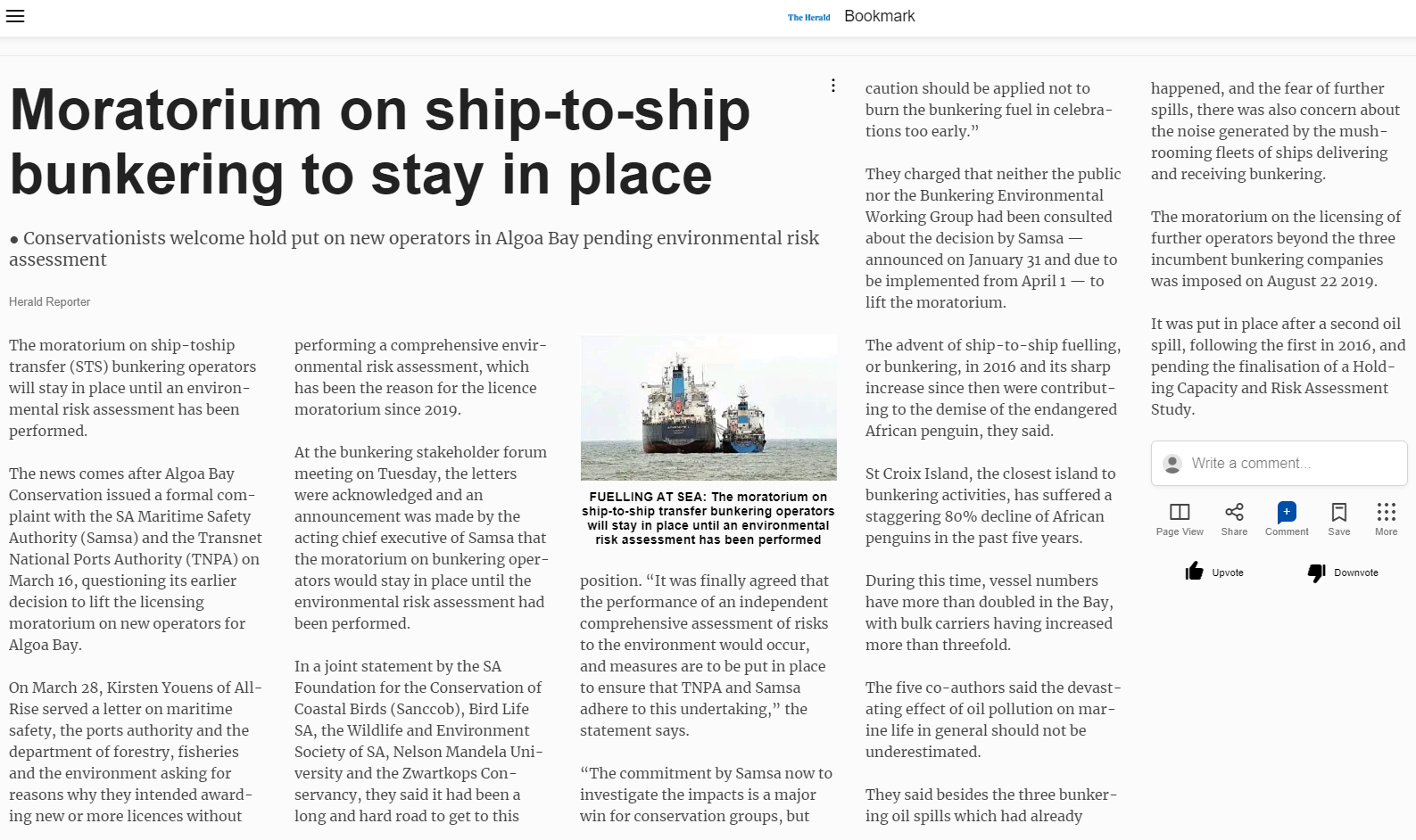
Celebrations went on well into the night as the South African Marine Safety Authority extended the moratorium of granting of new ship to ship fuel transfer licenses, until a comprehensive risk assessment has been carried out. This was a result of a legal letter drawn up by Kirsten Youens of All Rise Attorneys for Climate and Environmental Justice. A big thank you to Kirsten who did all this work pro bono. The client who brought the application was Nelson Mandela Bay Tourism. Well done on seeing this through. Plenty of work was done by our own eco warriors, Ronelle Friend and Michael Bellis. Without their extreme dedication in doing this unpaid work, we would be staring at another two companies spewing out their toxins into our beautiful Algoa Bay.
We have been asking for this risk assessment to be undertaken since 2019. All the media coverage, TV shows and the petition no doubt added impetus to SAMSA’s decision. The facts were so well spelt out that SAMSA had very little choice but to comply. Although media coverage and public opinion is important, the only way government institutions seem to take notice is via the legal route. Thank you to everyone who was involved . . . it is a great win for Algoa Bay. This is not the end, but only the beginning. There is still a long uphill battle on the cards.
THANK YOU TO ALL WHO DID THE CLICK AND SIGNED THE PETITION!
ALGOA BAY CONSERVATION : OFFSHORE MARINE REFUELLING
Algoa Bay Conservation (Baywatch Project, Nelson Mandela Bay Tourism and Raggy Charters) has prepared the following information document to record and inform on the ongoing progression of the marine offshore refuelling project and the impact on the Algoa Bay marine environment and associated tourism and other sectors that depend on a healthy Algoa Bay.
bunkering_algoa_bay_conservation_information_april_2022_version_25_3.pdf
Algoa Bay Conservation Project: Protect our Penguins in Algoa Bay
The following activities have been identified as key actions to protect the penguins, specifically declining numbers from St Croix Island, in Algoa Bay.
watch special edition of Gino’s Spot to sound the alarm on the catastrophic consequences of the looming conservation disaster facing Algoa Bay
sHIP TO sHIP BUNKERING (rEFUELING AT SEA) 2nd PUBLIC MEETING
HELD 01 MARCH 2022
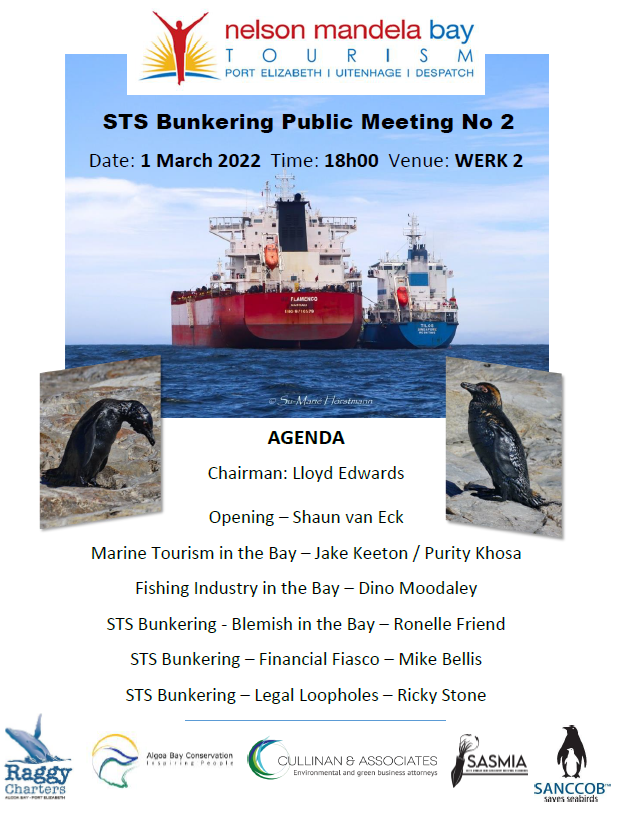
background to this project
17 November 2021
Wednesday 17 November at around 13:00 at least 80 litres of heavy fuel oil spilled into the ocean whilst the Croatian-flagged vessel, MV Solin was being refueled at sea by the bunker tanker Sea Express. The spill took place in a designated anchorage area known as Anchorage one. For now we know that a fuel tank on board the receiving vessel overflowed during the refueling process. The South African Maritime Safety Authority (SAMSA) is currently carrying out an investigation into the cause of the spill.
After the spill SAMSA initiated all relevant oil spill response teams as per the National Oil Spill Contingency Plan to assist with the containment and clean-up of the spilt fuel.
The question we have in mind is whether or not a precautionary boom was deployed before the transfer of fuel began? And could this have prevented the spilt fuel drifting across the bay and thus shortened the time it took to clean up the spill?
Although all species of marine birds are at risk when an oil spill occurs, with this spill taking place in Algoa Bay, not far from St Croix Island, special attention needs to be directed to the colony of endangered African Penguins that live and breed on St Croix Island. This colony that used to be ranked the world's largest breeding colony now only ranks as the fourth largest in South Africa with approximately 1500 breeding pairs left on the island. This figure is shockingly low considering that we had approximately 3600 breading pairs in 2019.
If there is to be any hope of the African Penguin colony on St Croix Island stabilizing and growing we need to protect them by mitigating the risk of having another oil spill in Algoa Bay.
This spill is the third spill that has been recorded in Algoa Bay since 2016, confirming that ship to ship bunkering in Algoa Bay is a major threat to the survival of the remaining African Penguins in Algoa Bay.
If you come across any oiled seabirds please contact SANCCOB Gqeberha on 041 583 1830.
If a large amount of oiled birds are found, SANCCOB may need assistance from public volunteers in the cleaning of oiled birds. Please keep an eye on our page as well as SANCCOB’s for updates and potential requests for volunteers.
We will be keeping penguin boxes on board our boats in case we come across any oiled birds at sea during our upcoming cruises in Algoa Bay.
Update: 03 December 2021
Thankfully there seem to be only a few peguins harmed this time. The only reason there were so few fatalities was because most of the penguins were molting at the time of the spill. Molting penguins are confined to their island breeding colonies for up to three weeks, so were not at sea when the spill happened. We have had great news from the Minister of Environmental Affairs re the bunkering and will make this known in due course.
Summary of the Presentations of 1st Public Meeting - Bunkering Operations in Algoa Bay - 1 August 2019
A public meeting was organized by Nelson Mandela Bay Tourism on 1 August 2019 to share concerns and inform the public about the ongoing Bunkering operations in Algoa Bay. 80 people attended the meeting at Dolphin’s Leap, Port Elizabeth.
Shaun Fitzhenry, from Nelson Mandela Bay Tourism, gave an introduction and explained how bunkering is a concern to tourism in the bay. Lloyd Edwards, from Raggy Charters, presented the biodiversity of marine life in the bay and highlighted the importance of protecting this resource. Ronelle Friend’s, from Enviro-Quest, presentation dealt with details of bunkering operations, the spill that occurred and the resultant impact on the environment. She also outlined the issues and concerns around the operation itself and the management thereof. A broad summary of the presentations are given here.
Biodiveristy in Algoa Bay – Presenter Lloyd Edwards, Raggy Charters
Algoa Bay is a biodiversity hotspot with the convergence of two oceans in the sea and the existence of rich fauna and flora on the land (5 biomes). As an ecotourism destination we can offer the tourist so much. Now with the declaration of the National Addo Elephant Park Marine Protected Area on the 1st August 2019 we can offer the Big 7 in fact. In close proximity to Algoa Bay we have numerous 5 star game parks to view the Big 5 land animals, while we have whales (humpback, right, minke, brydes and killer whales) and great white sharks present in our waters, making the viewing of the Big 7 possible. Other cetaceans in the bay are Common, Bottlenose and Humpback (listed as critically endangered by IUCN) dolphins.
We have Cape Fur Seals and a very rick marine life. Of further interest is the occurrence of 9000 pairs of endangered African penguins with their main breeding area at St Croix island, nearly half of the world population. Endangered Cape Gannets (90 000 pairs) breed on Bird Island, two-thirds of the global population.
Annual events are the world-famous sardine run that attracts international attention with film crew from National Geographic, BBC and many others. In addition the humpback whale migration from Antarctica up the eastern coast of South Africa for calving and then back again takes place from April to October every year.
The bay furthermore is an area of considerable research for the ocean and marine departments at various universities, not only the Nelson Mandela University in Port Elizabeth.
The rich biodiversity resulted in the declaration of Algoa Bay as a Hope Spot by Dr Sylvia Earle in 2014, the Bottlenose Dolphin Capital of the World in 2016 and a Marine Protected Area in 2019.
In 2017 a total of 3.4 million tourists visited NMBM and generated R 7 billion, with half through coastal and marine tourism. Tourism supported 44 227 local jobs in 2017.
It is thus sad that while on a tourist outing on a boat to St Croix islands in July 2019 we were met by Sanparks rescuing oiled penguins from St Croix. Then we learned about the spill during STS transferring of heavy fuel oil.
For the second time since bunkering operations started in 2016, the world’s largest breeding colony of African penguins, Cape Gannets and other marine life was put in jeopardy. Can we allow it any longer?
Bunkering in Algoa Bay – Presenter Ronelle Friend, Enviro-Quest
Over the last 3 years, Algoa Bay has witnessed an increase in bunkering operations, with large international vessels frequenting our bay for refuelling. Bunkering, the ship-to-ship transfer of fuel or oil from one vessel to another while at sea, is a high risk operation. (Basically a fuel station at sea)
3 Operators have been licenced by South African Maritime Safety Authority (Samsa) and Transnet National Port Authority (TNPA): Aegean Bunkering Marine Services Pty Ltd in 2016, South African Marine Fuels in 2018 and Colt Marine in 2019. Heavy Fuel Oil (HFO) and Marine Gas Oil (MGO) are the bunkering fuels.
50 ships can anchor at any time. Each operator has 1 mothership and 2 – 4 delivery vessels. Samsa is planning to obtain the SA Amandla tug to bring bigger ships into the anchorage for refuelling in 2019.
An oil spill from these operations can have major environmental consequences, impacting on other ocean industries such as tourism, water sports and fisheries. Although numerous objections were raised by marine scientists, environmentalists and tourism groups, licences to operate in the Bay were issued without performing any legal assessments and studies.
The public has never been informed of these operations. No public meeting has ever been set by any of the operators, or any of the governmental bodies. Thus there has been no environmental impact, socio-economic, ecological impact or traffic assessments. Furthermore, the emergency contingency preparedness for a major disaster in the bay has not been addressed.
The numerous requirements for such a high risk bunkering operation in a sensitive marine environment cause an overlap of governmental responsibilities, ranging from SAMSA, TNPA, Port of Ngqura, Department of Environmental Affairs, Sanparks,NMBM Municipality, etc. Is the overlap of responsibilities the possible reason why due diligence has not taken place when the bunkering operations were approved?
This video explains the process that should be followed before, during and after a STS Bunkering operation.
Oil spillage on 6 July 2019
As feared by many an incident took place during offshore bunkering operations less than 10km from the St Croix island. In the early morning (4h30) of 6 July 2019, while SA marine fuel were refuelling the vessel Chysanthi S, a spillage of HFO occurred.
A vast amount of oil spilled onto the vessel and due to the movement of the ship the oil ran over the sides of the ship into the ocean. Approximately 1600L (8X200L) drums of spilled oil were collected on the ship’s deck (and was re-used as a fuel), while ~ 400 L spilled over the sides into the sea. (A total of ~ 2000L of oil)
Even though a commercial oil spill response service provider was summoned to mitigate and contain the spread of the spill, more than 100 birds, all endangered species, were oiled. It took ~ 10 hours to recover 350L of the spilled HFO. 50L of HFO was left in the sea.
This is an ecological disaster for our Bay.
It was reported that the spill occurred because a valve on the receiving vessel was not secured after the transfer, resulting in an overflow. A final copy of the incident report has not been made available by Samsa, who indicated that the incident is still under investigation. Even though endangered birds were oiled, Chrysanthi S was fined a mere R350,000 and pay for the clean-up operations.
The birds collected by SanParks were taken to SANCCOB's (Southern African Foundation for the Conservation of Coastal Birds) Seabird Rehabilitation Centre near Cape Recife where staff and volunteers struggled to clean the birds. The issue was that the HFO that spilled stuck to the birds and numerous washes were required to remove it. It is therefore important to investigate the nature of the HFO that is transferred and handled in the bunkering process.
Nature of Heavy Fuel Oil
Heavy Fuel Oil is a viscous tar-like substance. It is the last bit of oil, dirt and gunge that remains after the fractionation distillation of crude oil. Since it is the remnants from the cracking and distillation process is has not been ”cleaned-up”. It is therefore contaminated with impurities, including sulphur and nitrogen compounds, as well as various metallic compounds.
Since it is the remnant substance from petroleum processes it is available at a relative low cost and HFO is therefore the preferred fuel for marine vessels.
HFO is classed as an aquatic polluter. It is very persistent in the environment and is extremely slow to biodegrade. Due to the viscous nature some of the HFO will sink, rather than float, making it impossible to recover by current spill control methods (skimmers and booms). Due to the toxins in HFO, even at low concentrations will kill certain species of fish, algae and plankton. HFO has therefore been classed as extremely toxic to aquatic environment with long lasting effects. A spill of HFO will thus persist in the environment for a long time (could be years), constantly releasing toxic compounds. This has a disastrous effect on biodiversity (fauna and flora) in that area. It will also bio-accumulate in marine life.
During the combustion of HFO (propulsion of marine vessels) the impurities cause several environmental issues, mainly air pollution (greenhouse gas emissions) and black carbon particle emissions. In addition spills from HFO have been identified as been extremely disastrous to an area due to its nature as outlined above.
It is for these environmental disaster reasons that the use of HFO as a fuel source in marine vessels travelling in the Antarctic has been banned by the International Maritime Organization (IMO). Currently there is a green movement underway to get HFO banned from the Artic areas as well.
Dimethylsulphide (DMS) is present in HFO as a contaminant. DMS is known to attract birds, fish and plankton in a marine environment. On a spillage of HFO the DMS will be released into the body of water. That is probably why such a high number of penguins were oiled when a relatively small spill of oil occurred in Algoa Bay in July 2019. They were attracted to the DMS which was present in the 400L of HFO that was spilled. (more than 100 penguins and gannets were oiled).
Apart from the affected penguins and gannets, the oil spill in Algoa Bay will have an impact on the total biodiversity of the bay, since toxins were continously released during the 10 hours that it took to clean up the spill. Some HFO must have sank as well. In addition HFO also forms an emulsion with water, making it difficult to skim off. Toxins, such as the long-chained hydrocarbons and organometallic compounds can be ingested by birds, fish and cetaceans. In addition it is well-known that algae and plankton will absorb toxin chemicals, which again can impact on various marine animals. The toxins from HFO will bio-accumulate in fish, animals and birds over time. The spread and impact of the toxins in Algoa Bay is uncertain at this stage.
Concerns from spillage on 6 July 2019
There are several questions that are raised by this spill:
What procedures were in place to prevent overfilling?
Why was oil transferred at night?
Why were no containment booms, absorbents, etc deployed by the transferring vessel? Is this not a marine legislation requirement?
Why was the spill only reported as Tier 1 alert? Surely the mere fact that endangered species were under threat would have raised it to a Tier 2 alert?
What happened to the missing 50L remaining oil?
What will be the response time and how long will it take to clean-up a major spill of, say a 1000L?
Why was no statement made by any other organization besides SAMSA? After all this was a serious ecological disaster.
What will the effect be on marine life and ecosystems from this spill over time?
Apparently a second spill occurred when the receiving vessel tried to remove the oil from the outside of the ship hull – this has not been reported.
What happened to that oil?
There is a total lack of emergency preparedness, according to SAMSA themselves. In March 2019, a SAMSA board member and chairperson of the agency’s Maritime Industry Committee, Ms Sekabiso Molemane described the country’s maritime risks as high and the state of readiness for emergencies as low.
This can only lead to the conclusion that the governmental organizations as well as the private bunkering companies, are not equipped to deal with a major spill. From the transferring of fuel, accidents including vessel collisions and major environmental disasters such as storms and other acts of God that my drive the vessels onto shore.
Summary of current concerns on bunkering operations:
In short:
1. Oil spill risk with catastrophic and severe consequences (accidents during transfer, vessel collision, or acts of god) impacting on endangered species
2. Effect of increased traffic and noise on marine life in the bay
3. Lack of emergency preparedness by operators and governmental bodies
4. Financial gains vs environmental protection
5. Total lack of transparency and public involvement – from all role players (DEFF, DOT, Sanparks, Port of Ngqura, TNPA, SAMSA)
6. Is this the best way to use the Bay‘s resources or should we be doing a Strategic Assessment that can guide us?
7. Decrease in quality of life, visual impact, movement of ships, unsightly bay horizon
8. Bunkering should not take place near a MPA
9. Fines for spills are too low
10. Stop bunkering till all the issues have been clarified.
Silence from other departments:
It is extremely upsetting that other departments are not expressing their concerns with the operations. We talk about Samsa in this presentation, however have the other role players been totally absent from the bunkering operations? For instance, SanParks and its Marine Protected Area must have some concerns? DEFF is also quiet in their role of preventing pollution in the seas and the requirements for an EIA. Overall it seems that the bunkering operations have been rolled out in a hurry without due consideration been given to the requirements of other departments, or are the other departments just not interested?
The way forward as we see it:
1. Approach Department of Environment, Forestry & Fisheries
We would like to request that STS bunkering be listed as an activity that requires an EIA (we are of the opinion that it is actually a listed activity, but need to investigate it further). The sole licencing operation must not rest with SAMSA, but jointly with DoT and DEFF.
We would also request that independent auditors be appointed and that an audit be done on current STS bunkering operations.
2. Submit Concern Report to DEFF and DoT
All the concerns raised verbally as well as those handed in after the meeting, will be collated into a concern report which will be handed to DEFF and DoT.
3. Stop all bunkering immediately!
Until all issues and concerns mentioned above are clarified, bunkering must be suspended in Algoa Bay.
With a proper EIA alternative ports can also be investigated for bunkering as well.
We are gambling with the biodiversity of Nelson Mandela Bay… can we afford this any longer?
thank you…
For more information please contact:
Ms Ronelle Friend Environmental Scientist Phone: 083 636 1156 email: ronelle@baymt.co.za
Mr Shaun Fitzhenry Head, Nelson Mandela Bay Tourism Phone: 076 191 3981 email: chair@nmbt.co.za
Results of Concerns collated at Bunkering Meeting
After the presentations the floor was opened for discussions. At the meeting the attendees could raise their concerns or issues in writing if they wanted. Questions were asked on the confidence that they have that the bunkering operations are managed well and if bunkering should be continued or not. They could then also indicate their top concerns or positive issues. Fifty people submitted written responses. The top concerns that were raised are as follows (from top to bottom):
1. Threat of oil spills and pollution from the bunkering operations
2. Threat to the biodiversity in the bay (vessels moving, noise, spills, fires, ecosystem damage)
3. Efficient management of the bunkering operations is lacking – for example no public involvement, no co-governance, 2 spills in 3 years are serious, not proactive, arrogant, etc. No dialogue is forthcoming.
4. Effect on tourism that will be negative from visual impact, impact of biodiversity, possible spills that can impact ecotourism and beaches, etc.
5. Legal issues – if bunkering is actually legal, why is precautionary principle not taken, no EIA’s been done, only SAMSA and TNPA are involved, what about DEFF and DoT, etc.
6. Financial gain – is the financial gain of a few individuals really assisting the region to the possible determent of the environment.
7. Job losses – from the current employment in bunkering and chandlers.

The respondents had to indicate if they have confidence that the bunkering operations are managed efficiently, that procedural controls are in place and that the government departments are effectively overseeing the operations. 85% indicated that they do not have confidents in the effective management of the current bunkering operations in Algoa Bay.
The responds to a question if bunkering should be continued or not in Algoa Bay, 88% of the respondents indicated that it should be stopped, while 12% indicated that it should be continued while improvements are being made.

Click here for the full PUBLIC CONCERNS REGARDING SHIP-TO-SHIP BUNKERING IN ALGOA BAY
To read how it all started follow this link to our News Article: https://www.raggycharters.co.za/article/raggy-charters-fights-against-oil-spills-in-algoa-bay
By Giles Fearon: Oil spill scenario modelling due to offshore bunkering operations in Algoa Bay
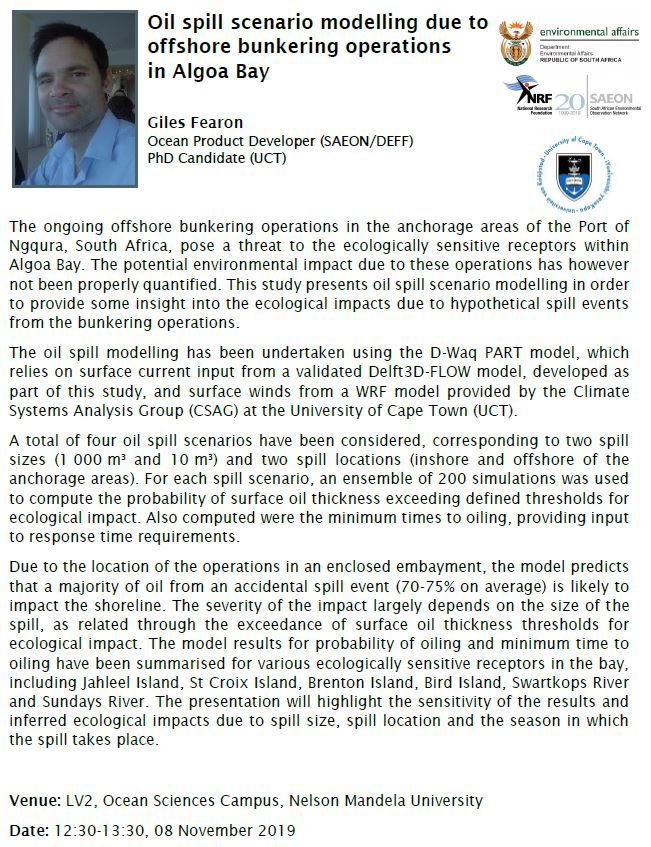
Read the Publication on Daily Maverick 23 January 2020
Algoa Bay Conservation put this very informative video together, a great explanation about bunkering and the damage caused.
(see more about bunkering on Algoa Bay Conservations YouTube Channel)
In July 2020 Sofia Christensen, Journalist for Agence France Presse, and Marco Longari, Photographer for AFP Photographs Jhb, joined us on a cruise into Algoa Bay and during the cruise interviewed Ronelle Friend on the Bunkering situation in Algoa Bay. Read the full article published in THE CITIZEN on 17th August 2020 here.
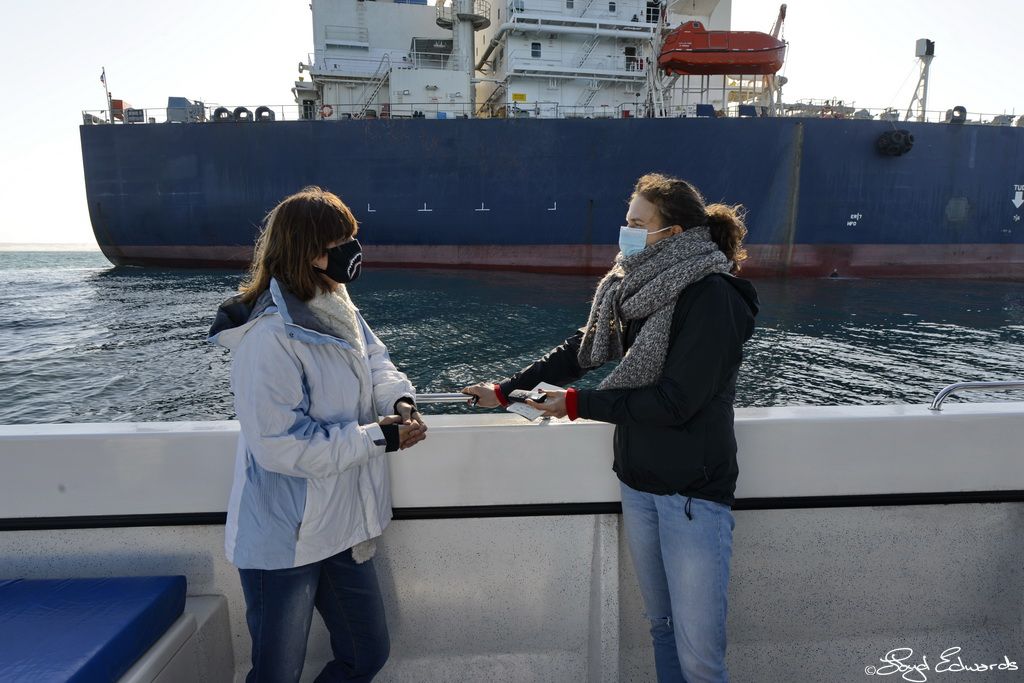

Downloads
- PDF - 20191212_concern_report_nmbt_2019_sts_bunkering.pdf - 1.97MB
- PDF - 20191212_concern_report_nmbt_2019_sts_bunkering180282951.pdf - 1.97MB
- PDF - algoa_bay_conservation_information_on_sts_refuelling_march_2022.pdf - 783.21KB
- PDF - abc_rc_penguin_project.pdf - 453.78KB
- PDF - bunkering_algoa_bay_conservation_information_april_2022_version_25_3.pdf - 644.56KB































































